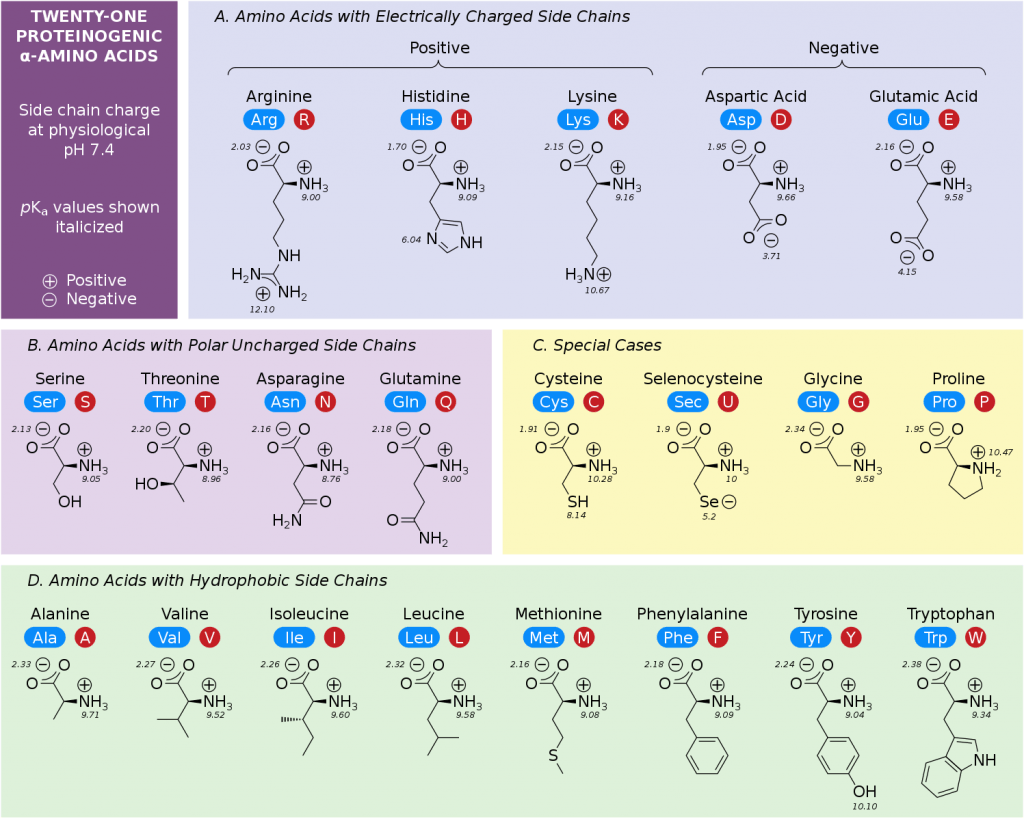Core Concepts
In this tutorial, you will learn about the 20 amino acid structures, along with their important biochemical properties.
Topics Covered in Other Articles
The Amino Acid
Amino acids are the building blocks for polypeptides and proteins. They are important pieces of our bodies and assist in many processes such as protein synthesis. In each amino acid, an amino group and a carboxylic acid group attach to a carbon. However, amino acids are different from each other based on the composition of their R groups.

20 amino acids make up all proteins. To repeat, the only difference in their structures is their R groups. The simplest or smallest amino acid is glycine. In particular, glycine has hydrogen as its R group. Their different side chains are categorized by charge, hydrophobicity (how they react with water), and also polarity. As a result, these three properties affect the way they interact with their surroundings within polypeptides and proteins. This also affects the 3D structure and properties that a protein has.
Amino Acid Chart
The chart below has 21 amino acids. However, selenocysteine is not part of the 20 essential amino acids that are in proteins.

Amino Acid Side Chains
Amino Acid Hydrophobic Side Chains
The amino acids below all have a side chain that then makes them to be hydrophobic. This property makes them “water fearing” or unable to dissolve in water.
Alanine (Ala) is the first hydrophobic amino acid, and it has low reactivity. This property allows for alanine to create an elongated structure that is equally flexible and stretch resistant.

Valine (Val) is able to break down into simpler compounds within our bodies.

Isoleucine (Ile) is important when the tertiary structure of a protein it is included in is being determined.

Leucine (Leu) is similar to valine where it is degraded into simpler compounds within the body. However, it is degraded through the use of enzymes.

Methionine (Met) prevents the accumulation of fat in the liver and detoxifies wastes and toxins.

Phenylalanine (Phe) can break down into tyrosine within the body.

Tryptophan (Trp) can break down in the human gut. Also, it can convert into vitamin B3.

Tyrosine (Tyr) is also an important precursor to vital hormones within our bodies. It is within the adrenal hormones (epinephrine and norepinephrine), the thyroid hormones (thyroxine), and melanin (responsible for hair and skin pigment). Phenylalanine produces tyrosine.

Amino Acid Neutral Side Chains
The amino acids below all have side chains that are polar neutral. This means that their side chains are neither acidic nor basic.
Asparagine (Asn) is responsible for removing ammonia (a toxic chemical) from our bodies.

Glutamine (Gln) is the most abundant amino acid in our bodies, and it performs several functions. It is responsible for regulating toxic ammonia and urea in our bodies. The reason glutamine can remove toxic ammonia is because its carboxyl side chain can act as a donor and acceptor for ammonia (this then allows for the safe transport of ammonia in our bodies).

Serine (Ser) is involved in biosynthesis of metabolites and is important in the catalytic function of enzymes.

Threonine (Thr) is within reactions in bacteria and metabolic rate in animals. However, the exact effect has not yet been determined.

Amino Acid Acidic Side Chains
Aspartic acid (Asp) is water soluble, which then allows it to be near the active sites of enzymes.

Glutamic acid (Glu) is similar to aspartic acid and is highly soluble in water.

Amino Acid Basic Side Chains
Arginine (Arg) is produced when proteins are digested within our bodies, and it is converted into nitric oxide (responsible for relaxing blood vessels).

Histidine (His) within proteins acts as both a proton acceptor and donor. Due to this property, histidine can combine into enzymes involved in the metabolism of proteins, carbohydrates, and nucleic acids.

Lysine (Lys) is in the binding enzymes to coenzymes. It plays an important role in the way that histones function. Specifically, it binds to histone acetyl transferases which alter the transcription of certain genes.

Amino Acids with Special Cases
Cysteine (Cys) is able to form disulfide bridges between to peptide chains and also form loops within a singular chain.

Glycine (Gly) is unreactive when it is in proteins. The biosynthesis of serine (amino acid), purines, heme (part of hemoglobin found in the blood), and also glutathione (coenzyme) all require glycine.

Proline (Pro) is made from glutamic acid. When it is in a protein it causes sharp bends to occur in the peptide chain, altering the protein’s final structure


